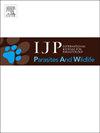Host dietary niche and site location on the river continuum shape trematode (Renifer aniarum) infection patterns in sympatric watersnakes (Nerodia spp.)
IF 2.2
3区 医学
Q3 ECOLOGY
International Journal for Parasitology-Parasites and Wildlife
Pub Date : 2025-10-03
DOI:10.1016/j.ijppaw.2025.101144
引用次数: 0
Abstract
Although parasite probability of infection and intensity are central to understanding parasite distributions and their ecological and evolutionary impacts, the drivers of these parameters remain poorly understood. At a local scale, we examined how host dietary niche partitioning and river landscape processes influence infections of the trematode Renifer aniarum in a community of watersnakes (Nerodia spp.). Host-specific dietary preferences and body size (SVL) were associated with infection probability among sympatric congeners. However, contrary to predictions of the stream drift hypothesis, infection probability increased with distance upstream. Infection intensity, in contrast, was unrelated to stream position and less predictable across host species. Thus, infection probability and intensity were heterogeneous among host species and across the river system. These results highlight that, even at local scales, multiple factors can distinctly shape the infection dynamics of a generalist parasite across closely related, co-occurring hosts.

宿主食性生态位及其在河流连续体中的位置决定了同域水蛇吸虫(Renifer aniarum)的感染模式。
虽然寄生虫感染的概率和强度是了解寄生虫分布及其生态和进化影响的核心,但这些参数的驱动因素仍然知之甚少。在局部尺度上,我们研究了宿主饮食生态位分配和河流景观过程如何影响水蛇(Nerodia spp.)群落中动物吸虫的感染。宿主特有的饮食偏好和体型(SVL)与同域同系物的感染概率有关。然而,与流漂假说的预测相反,感染概率随着上游距离的增加而增加。相比之下,感染强度与河流位置无关,并且在宿主物种之间难以预测。因此,感染的概率和强度在不同的宿主物种之间和整个河流水系之间是异质的。这些结果强调,即使在局部尺度上,多种因素也可以明显地塑造一种多能寄生虫在密切相关的共同发生的宿主之间的感染动态。
本文章由计算机程序翻译,如有差异,请以英文原文为准。
求助全文
约1分钟内获得全文
求助全文
来源期刊

International Journal for Parasitology-Parasites and Wildlife
Medicine-Infectious Diseases
CiteScore
3.80
自引率
5.60%
发文量
113
审稿时长
45 days
期刊介绍:
The International Journal for Parasitology: Parasites and Wildlife (IJP-PAW) publishes the results of original research on parasites of all wildlife, invertebrate and vertebrate. This includes free-ranging, wild populations, as well as captive wildlife, semi-domesticated species (e.g. reindeer) and farmed populations of recently domesticated or wild-captured species (e.g. cultured fishes). Articles on all aspects of wildlife parasitology are welcomed including taxonomy, biodiversity and distribution, ecology and epidemiology, population biology and host-parasite relationships. The impact of parasites on the health and conservation of wildlife is seen as an important area covered by the journal especially the potential role of environmental factors, for example climate. Also important to the journal is ''one health'' and the nature of interactions between wildlife, people and domestic animals, including disease emergence and zoonoses.
 求助内容:
求助内容: 应助结果提醒方式:
应助结果提醒方式:


